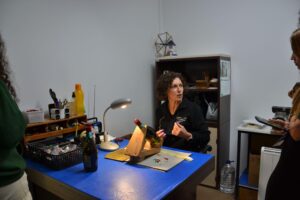
From remedy to tradition, Lourinhã’s brandy it became a lasting legacy in the region
The history of brandy in Lourinhã started with the french invasion, when a french soldier stole grapes from his neighbour to make the drink. It was used as a disinfectant for the wounded and as a drink for everyone. That same soldier was later welcomed by a Portuguese family and started a business selling the beverage.
In 1992, Lourinhã became a DOC (Demarcated of Controlled Origin) region, which made it the only one in Portugal and one of three in Europe, along with Armagnac and Cognac. This makes the brandy made there especially valuable. It was around this time when the market preferences shifted, making it unprofitable to sell the wine they used to sell. Due to these changes, they specialized exclusively on brandy after 1996. All materials needed for the manufacturing, from the grapes to the labels, are produced nationally, thus supporting local companies.
To get this brandy they start by making wine and then distill it, which culminates in a more concentrated drink, and 10 liters of white wine only produce 1 liter of brandy. The Lourinhã region is the ideal place for this activity because of the micro climate and the varieties of grapes that grow there. But, due to climate change, the date in which the grapes are picked had to be altered from the second week of September to the last week of August in order to keep the acidity and sugar levels of the grapes in the optimal range.
As a measure against pollution, the cooperation only uses pesticides (sulfur) when absolutely necessary and recycles all the materials it uses, paper, cardboard, plastic packaging, glass bottles etc.. They also reuse wooden barrels, when they can no longer use them to make brandy, they send them to other companies to be reused, or when this is not possible, they make furniture with the wood. They can also recycle grape residues that they do not use, as there is brandy that comes from the distillation of these same residues, such as the seeds, skins, pomace and solid parts of the grape.
Even with all this effort, they still recognise that there is still room for improvement. For example, the bottles come with an extra cork, which is sealed airtight inside a plastic bag, since the cork reacts with the oxygen in the air . “We would love it if someone suggested a better solution to this problem”, says Nádia Santos, an employee for 13 years.
“They used to say that wine gives food to many people”, said Nádia, as in the past farmers were paid with bottles of wine. This activity isn’t being affected too seriously with climate change, but as the situation worsens some people fear that the production will be compromised.
There is a whole research project, started by the scientist Pedro Belchior, which aims to study and understand which tree has the best wood that, when aged in it, gives the brandy specific aroma, color and taste. Nádia is currently continuing this research and dedicating part of her time to these studies. There are three types of wood that have been considered the best for aging this brandy: wood from Chestnut, Oak and French Oak (allier and limousin). The Chestnut offers the wood that is the most economical to produce barrels and it is also the one that can be reused most times to age the brandy, reducing the human footprint.




You must be logged in to post a comment.